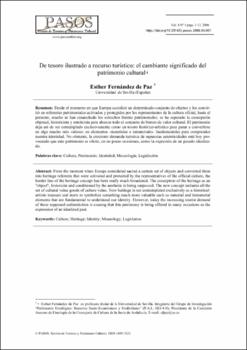De tesoro ilustrado a recurso turístico: el cambiante significado del patrimonio cultural
Autor
Fernández de Paz, EstherFecha
2006Resumen
Desde el momento en que Europa sacralizó un determinado conjunto de objetos y los convirtió
en referentes patrimoniales activados y protegidos por los representantes de la cultura oficial, hasta el
presente, mucho se han ensanchado los estrechos límites patrimoniales; se ha superado la concepción
objetual, historicista y esteticista para abarcar todo el conjunto de bienes de valor cultural. El patrimonio
deja así de ser contemplado exclusivamente como un tesoro histórico-artístico para pasar a convertirse
en algo mucho más valioso: en elementos -materiales e inmateriales- fundamentales para comprender
nuestra identidad. No obstante, la creciente demanda turística de supuestas autenticidades está hoy provocando
que este patrimonio se oferte, en no pocas ocasiones, como la expresión de un pasado idealizado. From the moment when Europe considered sacred a certain set of objects and converted them
into heritage referents that were activated and protected by the representatives of the official culture, the
border line of the heritage concept has been really much broadened. The conception of the heritage as an
"object", historicist and conditioned by the aesthetic is being surpassed. The new concept includes all the
set of cultural value goods of culture value. Now heritage is not contemplated exclusively as a historicalartistic
treasure and starts to symbolize something much more valuable such as material and immaterial
elements that are fundamental to understand our identity. However, today the increasing tourist demand
of these supposed authenticities is causing that this patrimony is being offered in many occasions as the
expression of an idealized past.





